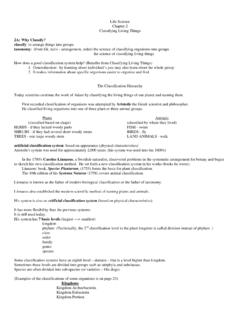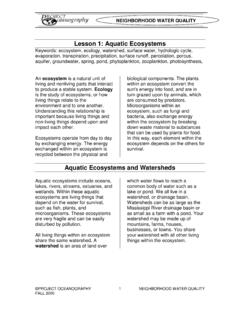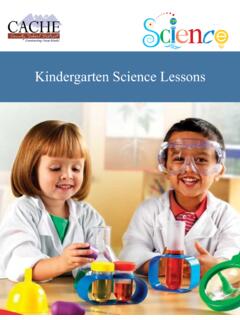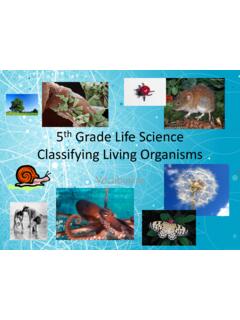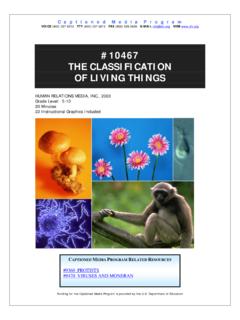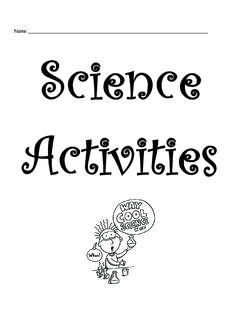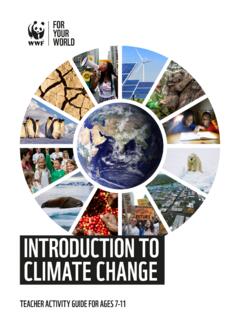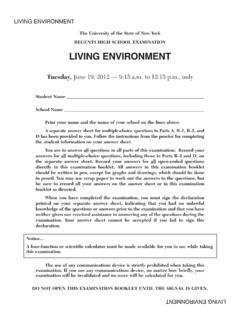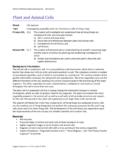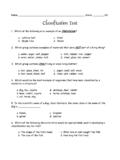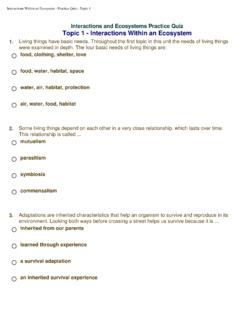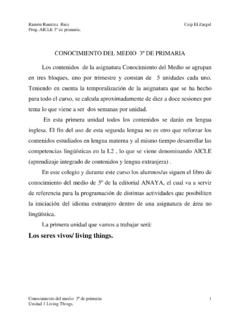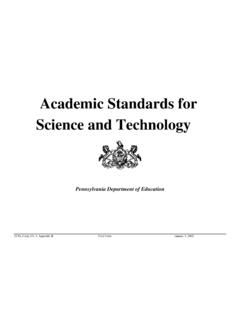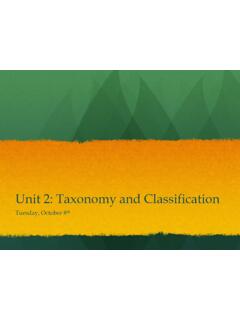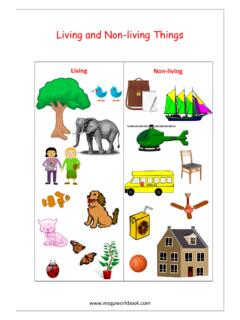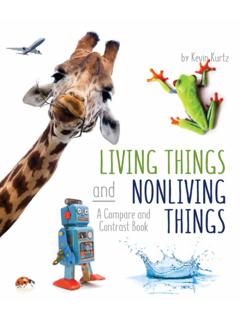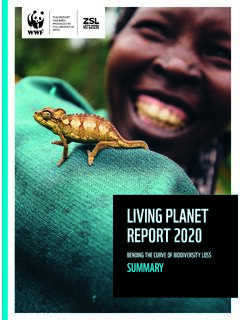Search results with tag "Living things"
Classification and Biodiversity - Prince Edward Island
www.edu.pe.ca*Living things reproduce themselves (and living things can only come from other living things) *Living things are adapted to their surroundings Title: Jan 219:21 AM (2 of 57) Classification Scientists classify organisms into groups. Why is this important? Classification allows us to organize living things in ways that help us understand ...
Classification of Living Things - BiologySc
biologysc.weebly.comClassification of Living Things Biology is defined as the study of living things and their interactions with the environment. There are 7 characteristics that distinguish living things from non- living
Chapter 2 Classifying Living Things - pjteaches.com
pjteaches.comLife Science Chapter 2 Classifying Living Things 2A: Why Classify? classify: to arrange things into groups taxonomy: (from Gk. taxis - arrangement, order) the science of classifying organisms into groups the science of classifying living things How does a good classification system help?
GRADE 7 NATURAL SCIENCES TERM ONE: LIFE AND LIVING …
tomnewbyschool.co.zaLiving things produce new individuals with the same characteristics as their parents. 4) Respiration (Breathing) Living things break down food to produce energy. 5) Excretion Waste substances are removed from the body. 6) Sensitivity to the environment Living things detect changes or stimuli in the environment and react to them. For example,
Teacher Notes/ Activity/Worksheets - Hamilton Zoo
hamiltonzoo.co.nzLiving World - Ecology - Explain how living things are suited to their particular habitat and how they respond to environmental changes, both natural and human-induced. Living World - Evolution -Begin to group animals and other living things into science based classifications. English Listening, Reading and Viewing Speaking, writing and Presenting
OW O ANTS MALS UNIT 7: Your Environment NEED CH OTHER?
www.alaska.edu2nd grade sequence #4: Living Things (Animals) B. Understand the needs of animals. C. Understands how we classify animals. D. Understands how animals grow and change. E. Uses scientific processes and inquiry to directly support the concepts of living things. 3rd grade sequence #4: Living Things (Animals)
UNIT 1 - NCERT
www.ncert.nic.inin a test tube is neither living nor non-living. Hence, while metabolism is a defining feature of all living organisms without exception, isolated metabolic reactions in vitro are not living things but surely living reactions. Hence, cellular organisation …
An Introduction to Biology - Emory University
www.tibet.emory.eduHow is the order of living things? Although there is no exact definition of life in general, most of the living things share certain key characteristics. These are, 1. Cellular organization. All living organisms consist of one or more cells. The cell is the basic unit of life. Each one of them carries the basic activities of living. Little more
Lesson 1: Aquatic Ecosystems - USF
www.marine.usf.eduliving things relate to the environment and to one another. Understanding this relationship is important because living things and non-living things depend upon and impact each other. Ecosystems operate from day to day by exchanging energy. The energy exchanged within an ecosystem is recycled between the physical and biological components. The ...
Name Score Classification - Warren County Public Schools
www.warrencountyschools.orgWhen grouping living things, place the most similar organisms in the same species. The largest, or most general, group of living things is the kingdom. ... Classification – To put things into groups of some kind. It is usually done based on some type of similarities.
NAME SCOPE NO. DATE PER. Form B CLASSIFICATION QUIZ
www.indiana.eduDATE_____ PER.___ Form B CLASSIFICATION QUIZ ____ 1. Which of these is the best definition of a living species? ... The classification system used for all living things is... A) permanent, not changing ... The classification system used for all living things is... A) permanent, not changing B) was permanent, but can change in the future
Unit 1 Characteristics and classification of living organisms
assets.cambridge.orgWelcome to the exciting and amazing world of living things. Go outside and look around you. Look at the sky, the soil, trees, plants, people, animals. Nature is all around you if you have the eyes to see it. Count how many living things you can see. ... CLASSIFICATION helps us to impose order and a general plan on the
Kindergarten Science Lessons
www.ccsdut.orga. Describe how parts are used to build things and how things can be taken apart. b. Explain why things may not work the same if some of the parts are missing. Standard 4 Life Science. Students will gain an understanding of Life Science through the study of changes in organisms over time and the nature of living things.
Name Score Classification
www.warrencountyschools.orgRules you need to follow when classifying g Know what is being classified. Make many observations about the things being classified. Classifyy things based on your observations. Group the most similar things together. When grouping living things, place the most similar organisms in the same species.
Classifying Living Organisms - PC\|MAC
images.pcmac.orgClassifying Living Organisms Vocabulary . Classification Grouping things by a set of rules . kingdom The largest group into which living things can be classified . species The smallest name grouping used in classification . vertebrates Animals with a backbone . invertebrates
CHAPTER 2 Interactions in Ecosystems - Miss S. Harvey
missharvey.weebly.comTo fully understand the world of living things, scientists look at how organisms interact with each other and with their environment. No living thing can exist in isolation. Every organism is linked to other organisms on the planet.Trying to understand all of the relationships that exist among different living things, as well as with their
Needs of Living Things - Mahopac Central School District
www1.mahopac.k12.ny.us(despite popular belief, you wil l not die without your cmpuo,ret cell phone or IPod) ... Living Space • A limited number of organisms can occupy a particular area • The number of organisms depends on the ... Needs of Living Things Author: Kimberly
Classification of Living Things - Biology Building Blocks
bioblocks.weebly.com• _____ - total of all the living things in an ecosystem. • _____ population of organisms that share similar characteristics and can breed with each other
Classification of living things - Midway ISD
www.midwayisd.orgclassification • All living things are grouped into 6 kingdoms: –Animalia –Plantae –Fungi –Protista –Eubacteria –Archaebacteria . Animalia • Kingdom Animalia is the animal kingdom • This kingdom has organisms that: – Are multicellular – Have eukaryotic cells
Classification of Living Organisms - Social Circle City ...
www.socialcircleschools.comClassification of Living Organisms I. General ... 1. Morphology is classification based on the structures possessed by the organism. 2. ... A change to the 5 and 6-kingdom systems is the evidence that all living things seem to fall naturally into three broad groups.
#10467 THE CLASSIFICATION OF LIVING THINGS
dcmp.orgliving things is one of the most fundamental aspects of classification. Another step in the history of classification came in the 1950s as scientists recognized that fungi are …
Required Vocabulary - mrscienceut.net
mrscienceut.netScientific Method Long ago, many people believed that living things could come from nonliving things. They thought that worms came from wood and that maggots came from decaying meat.
Science and Technology - Ministry of Education
www.edu.gov.on.camake things happen (to do work).Work is done when a force causes movement. Systems and Interactions A system is a collection of living and/or non-living things and processes that interact to perform some function. A system includes inputs, out-puts,and relationships among system components.Natural and human
Answer Key Unit 1 Diversity of Living Things
earlhaig.caUnit 1 Diversity of Living Things Unit Preparation Questions (Assessing Readiness) (Student textbook pages 4–7) 1. d 2. e 3. c 4. a. Photosynthesis is the process that producers, such as plants, algae, and some bacteria, use to chemically convert carbon from carbon dioxide into glucose using light energy from the Sun. Oxygen is also
Dig a little deeper All living things need minerals - NCERT
ncert.nic.inAll living things need minerals Life processes cannot occur without minerals. Although our mineral intake represents only about 0.3 per cent of our total intake of nutrients, they are so potent and so important that without them we would not be able to utilise the other 99.7 per cent of foodstuffs. Dig a little deeper and collect “Nutritional
INTRODUCTION TO CLIMATE CHANGE
www.wwf.org.ukThings will get worse if we do nothing, but if we act now we can limit the amount of damage we do to our planet, people and wildlife. By learning more about the science and geography that affects our world, young ... I can identify and classify examples of living things, past and present, to help me appreciate their diversity. I can
Teacher Notes/ Activity/Worksheets - Hamilton Zoo
hamiltonzoo.co.nz• To recognise that living things can be grouped into science- ... Teacher Notes/ Activity/Worksheets . Classification Page 2 of 13 Learning Intentions - Respect self, others and the environment ... Classification Page 3 of 13 Pre-visit Learning - Think about the different ways things …
Before you start to cringe at the thought of doing many ...
www.eequalsmcq.comChapter 1 Living and Non-Living Things 25-34 Chapter 2 Material and Non-Material Resources 35-47 Chapter 3 Reduce, Reuse and Recycle 48-56 Chapter 4 Habitats and Niche 57-71 Unit 2 Biomes Chapter 5 Grasslands and Forests 72-83 Chapter 6 More Forest Biomes 84-94 Chapter 7 Tundra and Desert 95-104 Chapter 8 Aquatic Biome 105-120
The University of the State of New York REGENTS HIGH ...
www.nysedregents.orgLiving Environment–June ’12 [2] 1 One characteristic of all living things is that they (1) develop organ systems (2) produce identical offspring
“Taxonomy Reading” - Loudoun County Public Schools
www.lcps.orgClassification allows scientists to organize information about living things and to help identify newly discovered organisms. The classification system that scientists use today was created in the 1700's by a
Plant and Animal Cells - VDOE
www.doe.virginia.govScience Enhanced Scope and Sequence – Life Science Virginia Department of Education © 2012 1 Plant and Animal Cells Strand Life Systems Topic Investigating organelles and their functions in cells of living things
Name Score - mrscienceut.net
mrscienceut.netIn the past scientists used to classify living things into either the plant or animal kingdoms. Today it is customary to use a classification system that uses five kingdoms,
A Kindergarten Inquiry Unit
www.globalproblems-globalsolutions-files.orgLesson Plans Day One STATE GOAL 12: Understand the fundamental concepts, principles and interconnections of the life, physical and earth/space sciences. A. Know and apply concepts that explain how living things function, adapt and
Interactions Within an Ecosystem - Practice Quiz - Topic 1
www.edquest.caInteractionsand Ecosystems - Topic 1 - Answers Interactions and Ecosystems Practice Quiz Answers Topic 1 - Interactions Within an Ecosystem 1. Living things have basic needs.
Los seres vivos/ living things. - juntadeandalucia.es
www.juntadeandalucia.esRamón Ramírez Ruiz Ceip El Zargal Prog..AICLE 3º de primaria.
Cambridge Lower Secondary Science Curriculum outline
www.cambridgeinternational.orgLiving things in their environment • Describe how organisms are adapted to their habitat, drawing on locally occurring examples. Secondary sources can be used. • •Draw and model simple food chains. • Discuss positive and negative influence of humans on the environment, e.g. the effect on food chains, pollution and ozone depletion.
TOPIC 3 Classification - Amazon Web Services
learnonassets.s3.amazonaws.comchange the classification of a particular organism and may even result in the proposal of new classification systems or categories. In the 1700s, Linnaeus proposed that living things could be grouped into three kingdoms.
WORKING SCIENTIFICALLY IN THE PRIMARY CLASSROOM
www.ciec.org.ukUse simple features to compare objects, materials and living things and, with help, decide how to sort and group them (identifying and classifying) Comments and asks questions about aspects of their familiar world such as the place where they …
KEY CONCEPT Scientists develop systems for classifying ...
www.classzone.comClassification and Taxonomy Tw o scientific processes deal with classifying and naming living things. is the process of arranging organisms into groups based
Academic Standards for Science and Technology
www.stateboard.education.pa.govLiving things are made of the same components as all other matter, involve the same kinds of transformations of energy and move using the same basic kinds of forces as described in chemistry and physics standards. ... classifying, inferring, predicting, measuring, computing, estimating, communicating, using space/time relationships, defining ...
Unit 2: Taxonomy and Classification
www.chicagoagr.orgOct 10, 2013 · All living things are related and share a single common ancestor that existed approximately 3.9 billion years ago. Since the beginning of life, there have been hundreds of thousands (possibly millions) of different organisms that have lived on our planet What we do know about these organisms, we’ve
Classification - ccmr.cornell.edu
www.ccmr.cornell.eduwhole organizational system for living things is called “classification.” It works like this: Suppose you wanted to classify a car. See Figure 3. The first group, or kingdom, would all be cars. That would exclude trucks, school buses, and RVs. The kingdom of cars would be further divided into all sedans.
Living and Non-Living Things - MegaWorkbook
www.megaworkbook.comHow to identify living things? 1) Living things Grow. www.megaworkbook.com 2) Living things Eat and Breathe. www.megaworkbook.com 3) Living things Reproduce. www.megaworkbook.com Exercise 1: Identify living things. www.megaworkbook.com Exercise 2: Circle the odd one in the group. www.megaworkbook.com ...
Living and Non-Living Activity Guide
www.nps.govclassify living and non-living things. Method By classifying things found in a classroom, students will learn to identify living versus non-living things. Background Living things have very specific characteristics. All living things need FOOD, water, reproduce, grow, move, breathe, adapt or respond to their environment, and produce
LIVING THINGS NONLIVING - Arbordale Publishing
www.arbordalepublishing.comby Kevin Kurtz LIVING THINGS and NONLIVING A Compare and THINGS Contrast Book
LIVING PLANET REPORT 2020
f.hubspotusercontent20.netThe 2020 global Living Planet Index shows an average 68% fall in monitored populations of mammals, birds, amphibians, reptiles and fish between 1970 and 2016. Species’ population trends are important because they are a measure of overall ecosystem health. Measuring biodiversity, the variety of all living things, is complex,
Similar queries
Classification, Living things, Classification of living things, Of living things, Living, Chapter 2 Classifying Living Things, THINGS, Teacher Notes/ Activity/Worksheets, Test, Unit, Lesson 1: Aquatic Ecosystems, Between, DATE PER. Form B CLASSIFICATION QUIZ, DATE_____ PER.___ Form B CLASSIFICATION QUIZ, Characteristics, Of living, Classifying, Classifying Living Organisms, Interactions, Exist, Relationships, Wil l, Classification of Living Organisms, THE CLASSIFICATION OF LIVING THINGS, Required Vocabulary, Nonliving things, Minerals, Learning, Classify, Chapter, Chapter 2, Taxonomy Reading, Loudoun County Public Schools, Plant and Animal Cells, Virginia Department of Education, Name Score, A Kindergarten Inquiry Unit, Interactions Within an Ecosystem - Practice, TOPIC 3 Classification, WORKING SCIENTIFICALLY IN THE PRIMARY CLASSROOM, Classifying things


